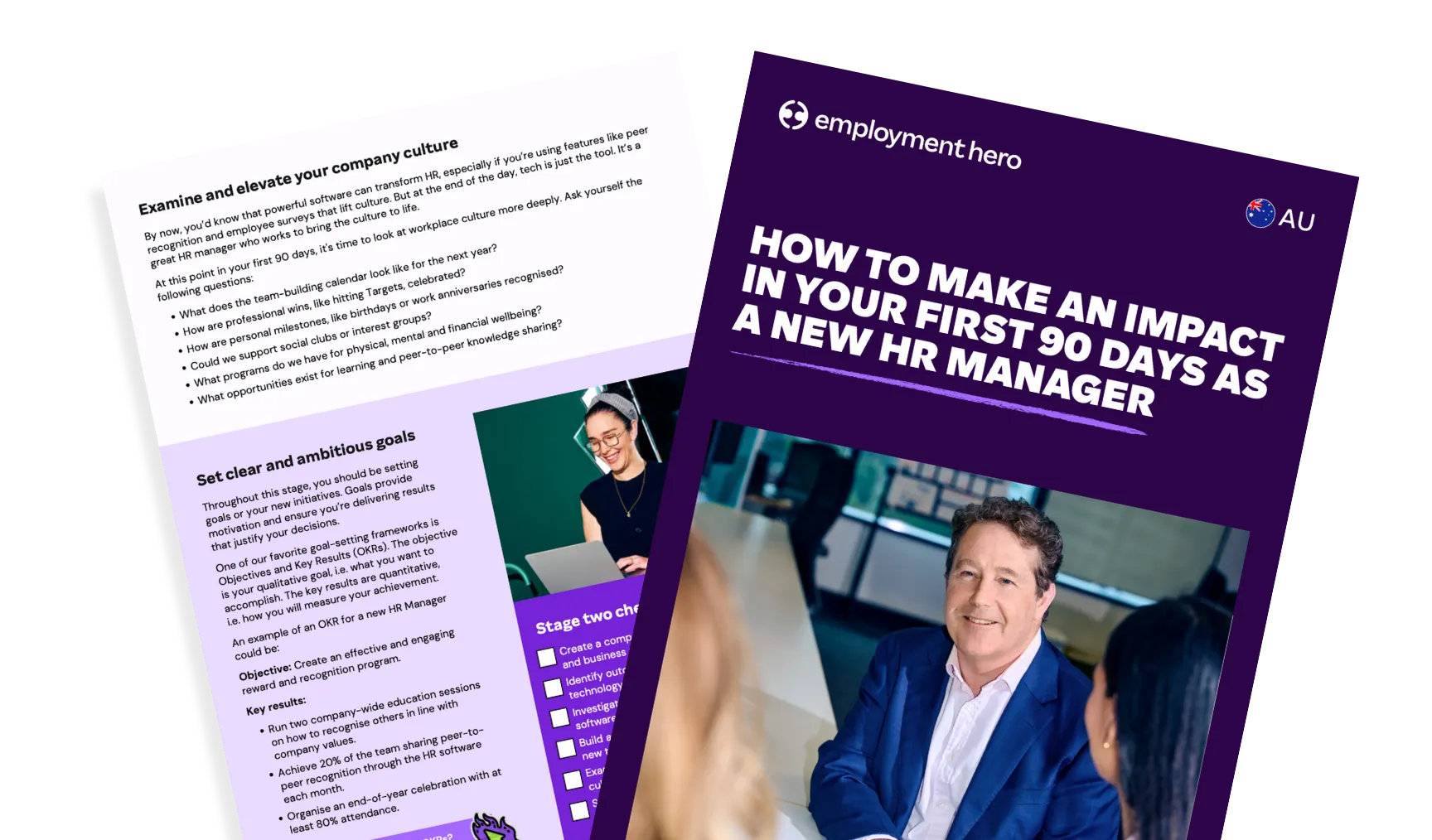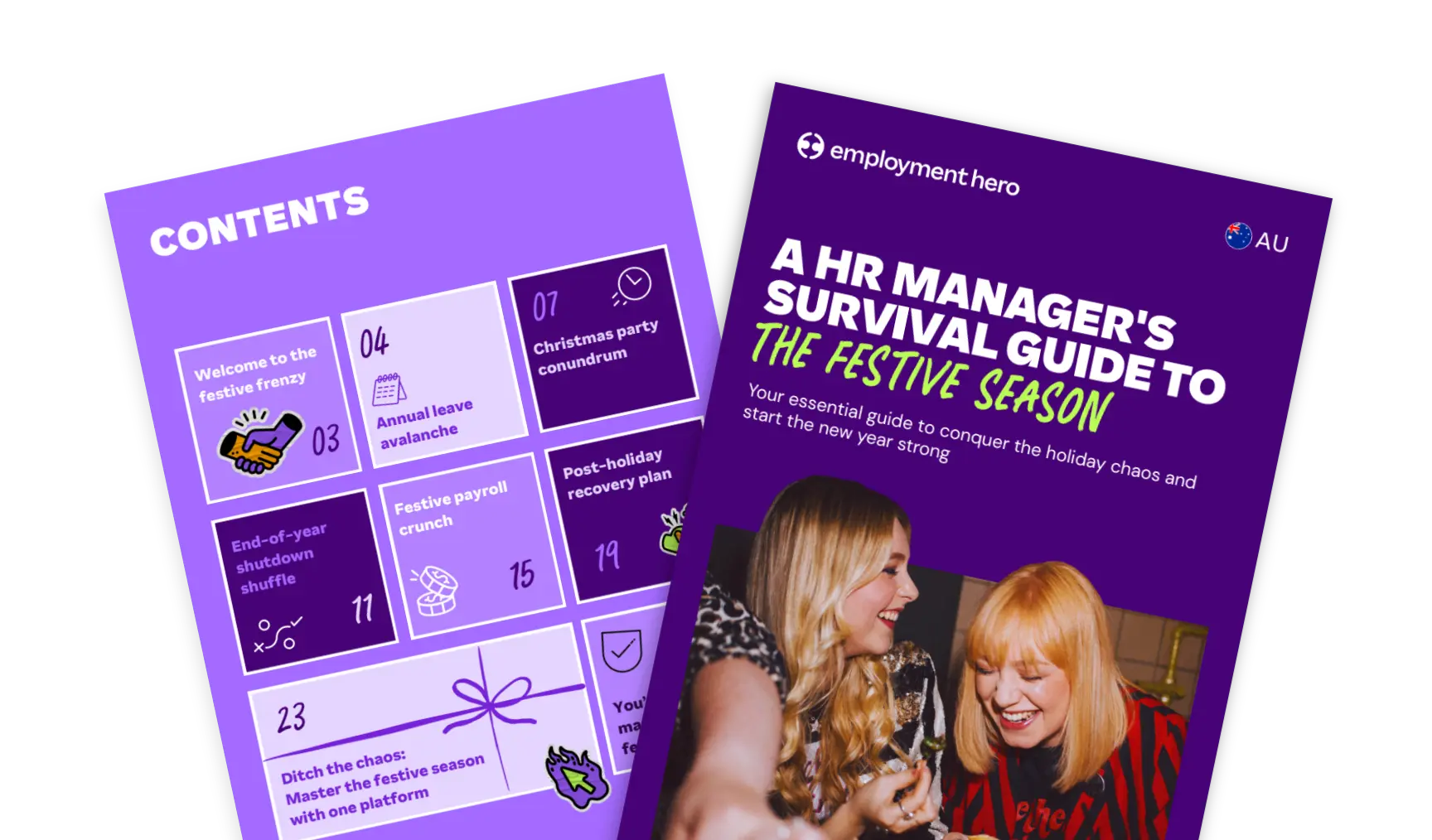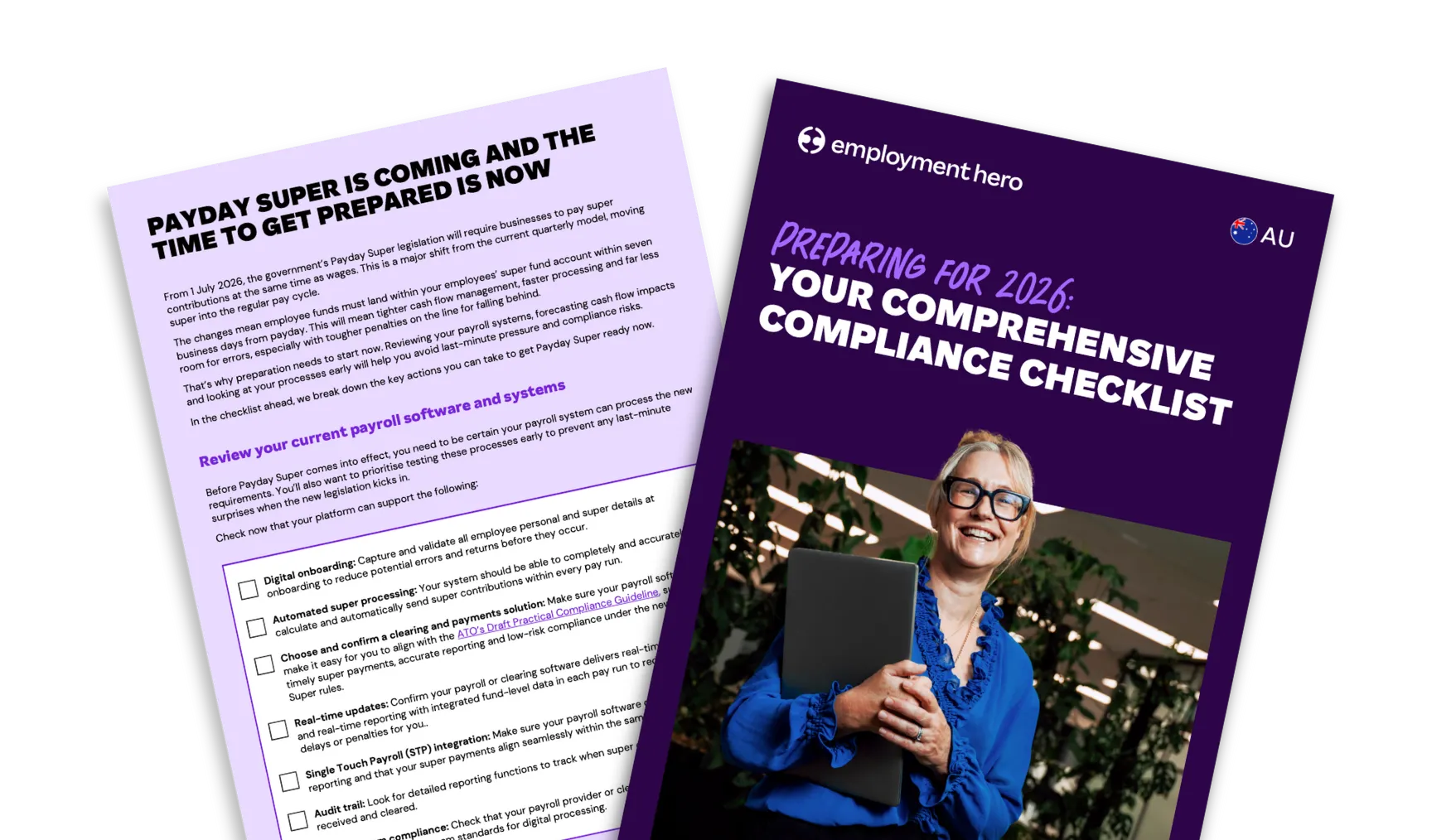Performance Improvement Plan (PIP) template and guide
Published
Performance Improvement Plan (PIP) template and guide

Do you have a team member who is falling behind? Maybe the quality of their work has taken a tumble or they’re not meeting the basic requirements of their role.
It’s a tough scenario for managers and employees to be in, but there are ways that you can improve the situation. A performance improvement plan is one of the most common tools that employers use to help their team members recover their performance.
This guide will walk you through everything you need to know about creating and implementing an effective performance improvement plan, complete with examples and a downloadable template to make the process smoother.
How can this performance improvement plan template and guide help?
This performance improvement plan sample can help you bring structure and consistency to this process. This template is designed to help you and your employee find transparency in the situation and make an actionable plan to move forward with.
In this employee action plan template, we’ve provided a structure to outline:
- A description of the underperformance occurring.
- Required outcomes and areas for improvement.
- Strategies to improve performance and the support leadership can provide.
- Consequences if the performance objectives are not met.
A robust template provides a consistent and fair framework for addressing performance issues. It makes sure you cover all the necessary components, from defining the problem to setting clear goals and outlining support.
What is a performance improvement plan (PIP)?
A performance improvement plan, often called a PIP, is a formal document that outlines specific performance issues and the steps an employee must take to improve. Think of it as a structured action plan designed to help a struggling employee succeed.
A PIP is typically used when informal feedback and coaching haven’t resolved an ongoing issue with an employee’s performance. The plan details the gap between the employee’s current performance and the company’s expectations, sets measurable goals for improvement and establishes a timeline for achieving them.
The ultimate goal of a performance improvement plan is to see the employee’s performance improve to a satisfactory level. It’s a chance for them to understand the issues, access support and demonstrate their ability to meet the requirements of their role.

Key components of a performance improvement plan
A comprehensive PIP should include several key elements to be effective. These components ensure clarity, fairness and a clear path forward.
- Details of performance issues: Clearly and objectively describe the specific areas of poor performance. Use concrete examples, data and dates where possible, avoiding vague statements.
- Clear objectives and goals: Outline what successful performance looks like. These performance goals should be SMART (Specific, Measurable, Achievable, Relevant and Time-bound).
- Defined timeline: Specify the duration of the PIP, which is often 30, 60 or 90 days. Include dates for regular check-in meetings to discuss the employee’s progress.
- Support and resources: Detail the support you will provide. This could include additional training, coaching from a manager, access to tools or regular mentoring sessions.
- Consequences of failure: The plan must clearly state what will happen if the employee achieves the goals and what the consequences are if the employee’s performance does not improve by the end of the period.
When to implement PIPs for employees
A PIP should be considered when other, less formal methods of addressing performance have not been successful. It is a significant step, so it’s important to use it in the right situations.
Consider implementing a performance improvement plan when:
- An employee consistently fails to meet the core requirements of their job.
- Informal coaching, feedback and regular one-on-ones have not led to improved performance.
- An employee’s work quality has noticeably declined over a period and is impacting the team or business outcomes.
- There are documented instances of behavioural issues, such as a persistent negative attitude or poor communication, that affect team morale and productivity.
- The performance issue is specific and measurable, making it possible to create a clear action plan for improvement.
Why use performance improvement plan templates?
Using a standardised performance improvement plan template can help streamline the process. A template acts as a guide, making sure no critical information is missed and that it’s managed the same way across the business.
Using templates also creates a level playing field, making sure that every employee is given the same opportunity to succeed. By having a pre-defined structure, you can focus on the substance of the conversation, rather than worrying about the format of the document.
This consistency is also vital for your business’s protection. A documented, uniform process demonstrates that you are managing performance issues fairly and without bias.

Advantages and disadvantages of performance improvement plans (PIPs)
PIPs are a powerful tool, but they have both pros and cons. Understanding these can help you decide when and how to use them effectively.
| Advantages | Disadvantages |
|---|---|
| Structure: A PIP provides a clear, documented path for improvement. It removes ambiguity about what needs to change and by when. | Can cause stress and anxiety: Being placed on a PIP can be incredibly stressful for an employee, potentially leading to disengagement or a drop in morale. |
| Opportunity for success: It gives the employee a genuine, structured opportunity to improve and get their career back on track. It shows the company is invested in helping them succeed. | Perceived as a formality before firing: Many employees view a PIP as the first step toward termination, which can make them defensive and less receptive to feedback. |
| Legal protection: A well-executed PIP process provides clear documentation of the performance issues and the steps taken to address them. This is crucial if termination becomes necessary. | Time-consuming: Creating and managing a PIP requires a significant time investment from managers for drafting the plan, conducting check-ins and providing support. |
| Improved communication: The process forces a direct and honest conversation about job performance, which can strengthen the manager-employee relationship if handled correctly. | Risk of demotivating the employee: If not handled with empathy, the PIP process may damage the employee’s confidence and job satisfaction. |
How to create a performance improvement plan (step-by-step)
Writing an effective performance improvement plan involves thought, clear communication and a genuine commitment to helping the employee succeed.
Step 1: Assess whether a PIP Is necessary
Before jumping to a PIP, review the situation. Have you provided clear, informal feedback? Have you conducted regular performance reviews? Sometimes, a simple, direct conversation is all that’s needed. A PIP is for persistent or significant performance issues that haven’t been resolved through regular management and coaching.
Step 2: Involve the employee in planning
Where possible, a PIP should be a collaborative process, not a top-down directive. Sit down with the employee to discuss the performance concerns. Listen to their perspective as there may be underlying issues or personal circumstances affecting their work that you’re unaware of.
Involving them in creating the action plan fosters a sense of ownership and makes it more likely they will engage with the process. However, if you can’t get buy-in from the employee, ultimately it’s up to you as to what goes into the PIP. It’s also best practice to allow an employee to have a support person present during these meetings.
Step 3: Set measurable goals and draft the plan
The core of the PIP is the set of goals for improvement. These must be specific and measurable. Instead of “improve communication,” use “provide a written weekly project update to the team every Friday by 4 PM.”
Use the information gathered to draft the plan. Clearly document the performance issues, the expected standards, the specific goals and the timeline.
Step 4: Identify support and resources
A PIP is about improvement and improvement requires support. Clearly outline what resources the company will provide such as additional training, weekly coaching sessions with a manager, access to new software or pairing them with a senior mentor. This shows you are invested in helping the employee succeed.
Step 5: Schedule regular check-Ins
The PIP is not a set and forget document. Schedule weekly or bi-weekly check-in meetings to track progress and discuss any challenges. These meetings are crucial for providing ongoing feedback, adjusting the plan if needed and keeping the employee motivated. Consistent check-ins help to monitor the employee’s progress toward their goals.
Step 6: Clarify expectations and consequences
Here you want to be transparent. The employee needs to know exactly what success looks like and what happens if they meet the goals of the performance improvement plan. Equally, they must understand the consequences if the performance issues are not resolved by the end of the PIP period. This clarity ensures there are no surprises for anyone involved.
How long should performance improvement plans go for?
The length of a performance improvement plan can vary depending on the complexity of the issues, but most fall within a 30, 60 or 90-day timeframe.
- 30-day PIP: Suitable for straightforward issues that can be corrected quickly, such as punctuality or meeting deadlines on smaller tasks.
- 60-day PIP: A common length that provides enough time for an employee to learn new skills or make significant changes to their work habits.
- 90-day PIP: Often used for more complex performance issues, such as improving strategic thinking, client relationship management or mastering a difficult new aspect of a role.
The key is to choose a realistic timeframe that gives the employee a fair chance to demonstrate improved performance.
Halfway point evaluation
A midway review is a critical checkpoint in the PIP process. It’s an opportunity to formally assess how things are going. During this meeting, you should review the employee’s progress against the goals, discuss what’s working and what isn’t and make any necessary adjustments to the plan or the support being provided. This evaluation helps keep the process on track and reinforces the goal of achieving a positive outcome./

Performance improvement plan examples
The nature of the PIP will depend on the specific performance issue. Here are some common scenarios and what a PIP might look like.
Often misses deadlines
Issue: “Employee regularly submits reports and project deliverables after the agreed-upon deadlines, impacting team workflow.”
Goal: “For the next 60 days, all assigned projects must be completed and submitted by the specified deadline. If a delay is unavoidable, it must be communicated to the manager at least 24 hours in advance with a new proposed deadline.”
Support: Weekly check-ins to review project timelines and workload management coaching.
Has received negative feedback from clients or customers
Issue: “Received formal complaints from three separate clients in the last quarter regarding communication style and unmet customer expectations.”
Goal: “Complete the company’s customer service training module by [Date]. Achieve a minimum average score of 8/10 on customer feedback surveys for the next 90 days.”
Support: Role-playing difficult customer scenarios with a manager and weekly reviews of client communications.
Delivering a low quality of work
Issue: “Reports submitted over the past two months have contained frequent errors and required significant rework from a supervisor.”
Goal: “For the next 30 days, all submitted reports must be free of factual errors and have a maximum of two grammatical/spelling mistakes per page. A quality checklist must be used before submission.”
Support: Access to a proofreading tool and a 30-minute review session with the manager before final submission of major reports.
Demonstrates persistent behavioural or attitude issues
Issue: “Employee has shown a pattern of negative commentary in team meetings and has been unresponsive to constructive feedback, affecting team morale.”
Goal: “For the next 60 days, actively participate in team discussions by contributing constructive ideas and refraining from negative or dismissive comments. Acknowledge feedback from colleagues and managers in a professional manner.”
Support: Bi-weekly coaching sessions focused on communication skills and a support person can be present if requested.
Attendance or punctuality concerns
Issue: “Employee has been late to work more than five times in the last month and has had two unapproved absences without prior notification.”
Goal: “For the next 30 days, arrive on time for all scheduled shifts. Any planned absence must be requested according to company policy and any unplanned absence must be reported to the manager before the shift starts.”
Support: A review of the company’s attendance policy and a conversation to understand if any external factors are impacting punctuality.
Identifying the root causes of poor performance
To truly help an employee improve, you need to understand why their performance is suffering. A PIP that only addresses the symptoms without getting to the root cause is unlikely to succeed. Consider these potential underlying factors.
Lack of resources or tools
Does the employee have everything they need to do their job effectively? Outdated software, a slow computer or a lack of access to necessary information can all be significant barriers to good job performance.
Organisational or process obstacles
Sometimes, the problem isn’t the employee but the system they are working in. Inefficient workflows, bureaucratic red tape or a lack of communication between departments can make it nearly impossible for anyone to succeed in a role.
Skills or knowledge gaps
Has the role evolved? Has new technology been introduced? An employee might be struggling simply because they haven’t received the proper training to meet the new demands of their job.
Unclear expectations or role confusion
If an employee doesn’t know what success looks like, they can’t achieve it. Vague job descriptions, shifting priorities or a lack of clear Key Performance Indicators (KPIs) can all lead to poor performance because the employee is never sure what they should be focusing on.
Lack of recognition or accountability
People are motivated when they see that their hard work is recognised and that everyone on the team is held to the same standard. A workplace culture where good work goes unnoticed and poor performance is ignored can lead to widespread disengagement.
Personal circumstances and wellbeing factors
Never forget the human element. Issues outside of work can have a huge impact on an employee’s performance. Health problems, family emergencies, financial stress or burnout are all valid personal circumstances that can temporarily affect a person’s ability to perform at their best.
Supporting employees during a PIP
The way you manage the PIP process is just as important as the document itself. A supportive approach can make the difference between a successful outcome and a failed one.
Lead with empathy and respect
Remember that being put on a performance improvement plan is difficult for the employee. Approach every conversation with empathy and treat them with respect. Frame the PIP as a tool to help them, not to punish them. This builds trust and makes them more likely to engage positively.
Give honest, constructive feedback
Sugar-coating the issues won’t help. Be direct and honest, but deliver feedback constructively. Focus on specific, observable behaviours and their impact on the business.
Use “I” statements (e.g. “I noticed that…”) rather than accusatory “you” statements (e.g. “You always…”).
Provide regular 1:1 meetings and check-Ins
Stick to the schedule of check-ins outlined in the improvement plan. These regular meetings are your chance to track employee performance, offer guidance and address any roadblocks. They keep the lines of communication open and show the employee you are committed to the process.
Offer practical support and coaching
Support shouldn’t just be a line item in the PIP document. It’s a chance for you to be an active coach. Can you demonstrate a better way to do a task? Can you connect them with a subject matter expert in the company? Proactive, hands-on support shows you are genuinely invested in helping the employee succeed.
What happens if a performance improvement plan fails?
Sometimes, despite everyone’s best efforts, an employee does not meet the goals of the performance improvement plan. If the PIP fails, you need to follow through with the consequences outlined in the plan.
This typically means moving toward termination of employment. Because you have followed a fair and documented process, this step is clearer and carries less legal risk.
You have evidence that the company identified the performance issues, provided a clear path to improvement, offered support and gave the employee a reasonable opportunity to meet the required standards.
How to prevent performance issues before they require a PIP
The best way to handle a performance issue is to prevent it from happening in the first place. A proactive approach to performance management can help you avoid the need for a formal PIP.
Foster a culture of continuous feedback
Don’t wait for the annual performance review to talk about performance. Create a culture where regular, two-way feedback is the norm. When managers and employees talk openly and often, small issues can be corrected before they become big problems.
Set clear goals and expectations early
From day one, employees should understand what is expected of them. Use frameworks like Objectives and Key Results (OKRs) to set clear, measurable goals. A detailed job description and a thorough onboarding process can also make sure that everyone is aligned on responsibilities and expectations from the start.
Download the free performance improvement plan template now
Ready to manage under-performance effectively? Use our guide and template as a structured path to get your employees back on track.
Download our free performance improvement plan guide and template today. It gives you a ready-to-use framework that includes all the essential components, helping you navigate difficult conversations and drive positive outcomes.
If you’re looking for more resources, take a look at our Performance Review Guide or How to Measure Employee Performance article.
Download the free performance improvement plan guide and template by filling out the form.
Disclaimer: The information in this guide and template is current as at November 2025, and has been prepared by Employment Hero Pty Ltd (ABN 11 160 047 709) and its related bodies corporate (Employment Hero). The views expressed in this guide and template are general information only, are provided in good faith to assist employers and their employees, and should not be relied on as professional advice. The Information is based on data supplied by third parties. While such data is believed to be accurate, it has not been independently verified and no warranties are given that it is complete, accurate, up to date or fit for the purpose for which it is required. Employment Hero does not accept responsibility for any inaccuracy in such data and is not liable for any loss or damages arising either directly or indirectly as a result of reliance on, use of or inability to use any information provided in this guide and template. You should undertake your own research and to seek professional advice before making any decisions or relying on the information in this guide and template
Download your template below
Related Resources
-
 Read more: Your first 90 days as an HR manager: a complete 30-60-90 day plan
Read more: Your first 90 days as an HR manager: a complete 30-60-90 day planYour first 90 days as an HR manager: a complete 30-60-90 day plan
Starting as an HR manager? Follow this 30-60-90 day plan to build trust, set strategy and make an impact in…
-
 Read more: HR Managers: Don’t just survive the festive season, master it
Read more: HR Managers: Don’t just survive the festive season, master itHR Managers: Don’t just survive the festive season, master it
Make year-end easier: manage leave, payroll, parties and shutdowns with confidence. Get practical tips for Australian SMEs. Download the free…
-
 Read more: Preparing for 2026: Your Compliance Checklist
Read more: Preparing for 2026: Your Compliance ChecklistPreparing for 2026: Your Compliance Checklist
Get your business ready for the 1 July 2026 changes. See practical steps for Payday Super, cash flow planning and…























